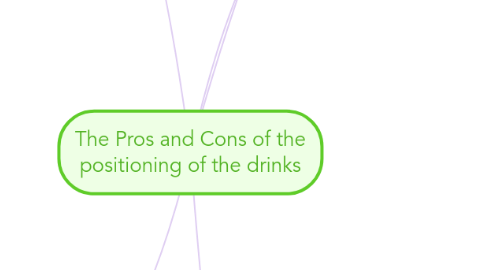
1. Energy drinks
1.1. Pros
1.1.1. increasing sales/ growing market
1.1.1.1. energy drinks market up by 40%
1.1.2. uniqueness in the market
1.1.2.1. organic certification and minimal caffeine content compared to leading competitors
1.1.2.2. healthier alternative to leading brands
1.1.3. low price
1.1.3.1. Crescent Pure price: $2.75;
1.1.3.2. Market average: $2.99
1.1.4. consumer perception
1.1.4.1. view 'energy' as the most descriptive characteristic of Crescent Pure
1.2. Cons
1.2.1. competitiveness
1.2.1.1. top 6 players account for 85% of revenues
1.2.2. quality issue
1.2.2.1. Some people question the company’s ability to deliver a quality product with all organic, healthy ingredients for just $2.75
1.2.3. health risks/negative perception
1.2.3.1. 11% of people are drinking less
1.2.3.2. negative campaigns against energy drinks
1.2.3.3. rising sales of healthier beverage choices
1.2.4. targeting group
1.2.4.1. mostly are male aged 18-24
1.2.4.2. Only 34% of consumers said they have consumed an energy drink in the past 6 months
1.2.5. below expectation
1.2.5.1. Some younger consumers think that Crescent has less energy than they had hoped
1.2.6. long-term viability of the market
2. Healthy drinks
2.1. Pros
2.1.1. health
2.1.1.1. nutrition
2.1.1.2. Energy boost is delivered through all natural herbal stimulants, guarana seed and ginseng.
2.1.1.3. Low calorie beverage: 70% less sugar than leading and energy drinks
2.1.1.4. internal cleasing
2.1.1.5. organic ingredients
2.1.2. beauty/ appearance
2.1.2.1. skin, body shape
2.1.2.2. weight loss
2.1.3. health trend/ fashion
2.1.3.1. Growing market size
2.1.4. prevention of diseases
2.1.5. larger consumer range
2.1.5.1. teens
2.1.5.2. elderly
2.1.6. Pricing
2.1.6.1. Ability to set a premium price as the quality ingredients is the focus and target consumers are willing to pay more.
2.1.6.2. Organic beverage claims an average 25% price premium over conventional beverage of the same variety.
2.2. Cons
2.2.1. Negative feedbacks from some young customers
2.2.1.1. Lack of energy provided
2.2.2. Insufficient advertising budget
2.2.2.1. With the wild range of consumers, the original advertising budget might not be feasible
2.2.3. Increasing administration expenditure
2.2.3.1. Larger amount of retailers and distributors are needed and further evaluation is required.
2.2.4. Time-consuming
2.2.4.1. In order to get quick entrants to the market, the positioning strategy needs to be asap. However, a wild range of target consumers require a broad launch process.
3. Sports drinks
3.1. Pros
3.1.1. Market size
3.1.1.1. Market increased 9% from 2007 to 2012 and expected to have a 52% growth within five years, from $6.3 billion in 2012 to $9.58 billion by 2017
3.1.1.2. New diet and low-sugar sports drinks were growth areas
3.1.1.2.1. The market has grown by 33% from 2010 to 2012. and it is expected to increasefrom $1.4 billion in 2012 to $2.97 billions in 2017
3.1.2. Consumer expectation
3.1.2.1. According to the 2012 Mintel Study on sports drinks
3.1.2.1.1. , 42% of sports beverage users did not associate sports drinks solely with athletics
3.1.2.1.2. Considered them as anytime beverages
3.1.2.2. sports drinks is brighter and more health-oriented
3.1.2.3. considered them as “anytime beverages”
3.1.2.4. expect sports drink 1.hydrating(49%), 2.Refreshing (34%), 3. Functional (28%)
3.1.2.4.1. Describe Crescent 1. Functional(47%), 2.Natural (38%), 3. Refreshing(35%), 4.Hydrating (29%)
3.1.3. Consumer experiences
3.1.3.1. They chose sports drinks more often
3.1.4. Feature of Crescent Pure
3.2. Cons
3.2.1. Market Size
3.2.1.1. 2.2 billion less than Energy Drink
3.2.2. Pricing = 2.75 USD
3.2.2.1. higher than competitors prices, usually between $1 - $2
3.2.2.1.1. once educated, the respondents think that the price is lower than expectation >$3
3.2.3. Obesity
3.2.3.1. Government has removed high-calorie sugary drinks and snacks, including sports drinks from school vending machines
3.3. Demographic
3.3.1. Gender
3.3.1.1. A third of women consumed them
3.3.1.1.1. 27% of females found sports drinks refreshing
3.3.1.2. Half of men consumed them
3.3.1.2.1. 40% of men found sports drinks refreshing
3.3.2. Age
3.3.2.1. 18 to 24 consumes 62%
4. Crescent Pure
4.1. 70% less sugar
4.2. Caffeine = 1 cup of coffee
4.3. Low calories
4.4. Energetic, Hydrating, Organic
5. Positioning Recommendation
5.1. Sports Drink
5.1.1. Stable market growth
5.1.1.1. Relatively slow growth
5.1.2. Energy boost
5.1.2.1. Improve athletic performance
5.1.2.2. Post-workout fatigue
5.1.2.3. Healthy alternative
5.1.3. Younger market target
5.1.3.1. Age 18-24-Men ratio
5.2. Energy Drink
5.2.1. Potential Market
5.2.1.1. Trending market
5.2.1.2. Unsure long-term growth
5.2.2. 40% Market Growth
5.2.3. Health benefits
5.2.3.1. Promotes mental focus
5.2.3.2. Contains caffeine
5.3. Organic Drink
5.3.1. Healthier option
5.3.1.1. Supports company's goals
5.3.1.2. Energy drink with less sugar
5.3.2. Less chemicals
5.3.2.1. Low sugar and caffeine
5.3.3. More costly to produce
5.3.4. Create demand in market
5.4. All-Natural Organic Energy Drink
5.4.1. Potential market growth
5.4.1.1. Combines energy & organic ingredients
5.4.2. Larger market audience
5.4.2.1. Targets the younger market
5.4.3. More expensive/more costs
5.4.3.1. Product will be more expensive
5.4.4. Promotes healthier company/product image

